EUP or AUP?
 Sunday, March 23, 2014 at 05:07AM
Sunday, March 23, 2014 at 05:07AM Schools should teach children to think, not to believe.
- My Biases
Scott McLeod suggests in a recent blog post that we stop telling kids what they can't do and start telling them what they can do when using technology and the Internet - moving from an Acceptable Use Policy to an Empowered Use Policy. (No mention of the tres chic Responsible Use Policy.)
He suggests:
How about an empowered use policy (EUP) instead? In other words, instead of saying NO, NO, NO! all the time, how about saying yes? Here’s one to consider…
When it comes to digital technologies in our [school / district], please…
Thank you and let us know if you have any questions.
- Be empowered. Do awesome things. Share with us your ideas and what you can do. Amaze us.
- Be nice. Help foster a school community that is respectful and kind.
- Be smart and be safe. If you are uncertain, talk with us.
- Be careful and gentle. Our resources are limited. Help us take care of our devices and networks.
As much as I like Scott's rules, I don't know that they go far enough in acknowledging the "safe" side of "safe and ethical behaviors." I've always viewed safe and ethical as two sides of a coin - ethical is what you do - safe is protecting oneself from the possible unethical actions of others.
Back in the mid-90s, I developed: Johnson’s 3 P’s of Technology Ethics:
- Privacy - I will protect my privacy and respect the privacy of others.
- Property - I will protect my property and respect the property of others.
- a(P)propriate Use - I will use technology in constructive ways and in ways which do not break the rules of my family, faith, school, or government.
My suggestion is to develop your own set of Acceptable/Responsible/Empowered rules for your classroom or library, stressing broad statements that require students to actually think about and categorize their own behaviors. Effective rules will ask students to think about how their behavior impacts others - including their "future" selves. And yes, Thou shalt frame them in positive language.
Have fun. And thanks, Scott, for the great post.
-----------------------
Here are a few other examples of how to express behavioral guidelines in a positive way:
Johnson’s Library Rule Rule: Never have more than three rules for your media center:
be doing something productive
be doing it in a way that allows others to be productive
be respectful of other people and their property.
Johnson's Rules for Use of Personal Technology in the Classroom: Student-owned technologies such as cell phones and laptops may be used in the classroom when there is not a whole-group activity, when their use does not distract other students, and when the district's Acceptable Use Policy is followed.
7 things you can always do in my class with your device.
Signs of a Welcoming Library, Library Media Connection, March/April 2010.










Reader Comments (5)
I have a suggestion for the third P in Johnson's 3 P's of Technology Ethics. Instead of "a(P)propriate Use - I will use technology in constructive ways and in ways which do not break the rules of my family, faith, school, or government."
We could use "Positive Use". My 2 cents - happy Sunday!
Len
I like the idea of framing AUPs in positive language, rather than the NO, NO, DO NOT, DO NOT language that most districts use. Love to see the reaction if I suggested to my Technology committee that we change our language. On the other hand, the suggestions for library I can implement. Thanks for the idea, Doug.
Hi Len,
So where were you 15 years ago when i wrote these three P's? Great idea.
The concept of appropriateness is a good one to teach, I think. What is perfectly fine in one circumstance (home for example) is not necessarily fine in another location (school for example). It's not the activity, per se, but venue in which the activity occurs that makes it OK.
Doug
Hi Teri,
While the board adopted AUP is the official document governing student and staff Internet use, most teachers and librarians create an adaptation of it. (I think I checked that there reading level of our AUP is about 7th grade, so it has to be simplified for younger students anyway.)
Take care,
I completely agree with this idea! it is so much more empowering to kids when we tell them what they can do, instead of what they can't do. I work in the Forsyth County (Ga.) school district, and this year we moved from AUP to Responsible Use Guidleines- http://www.forsyth.k12.ga.us/Page/41066 - the conversations that I had with students around these guidelines were so much more constructive and thought-provoking than any that I ever had with the AUP.
Thanks, Scott. I like this policy a lot - both for its simplicity and its positive focus. One this length also might even get read!
Appreciate the link,
Doug